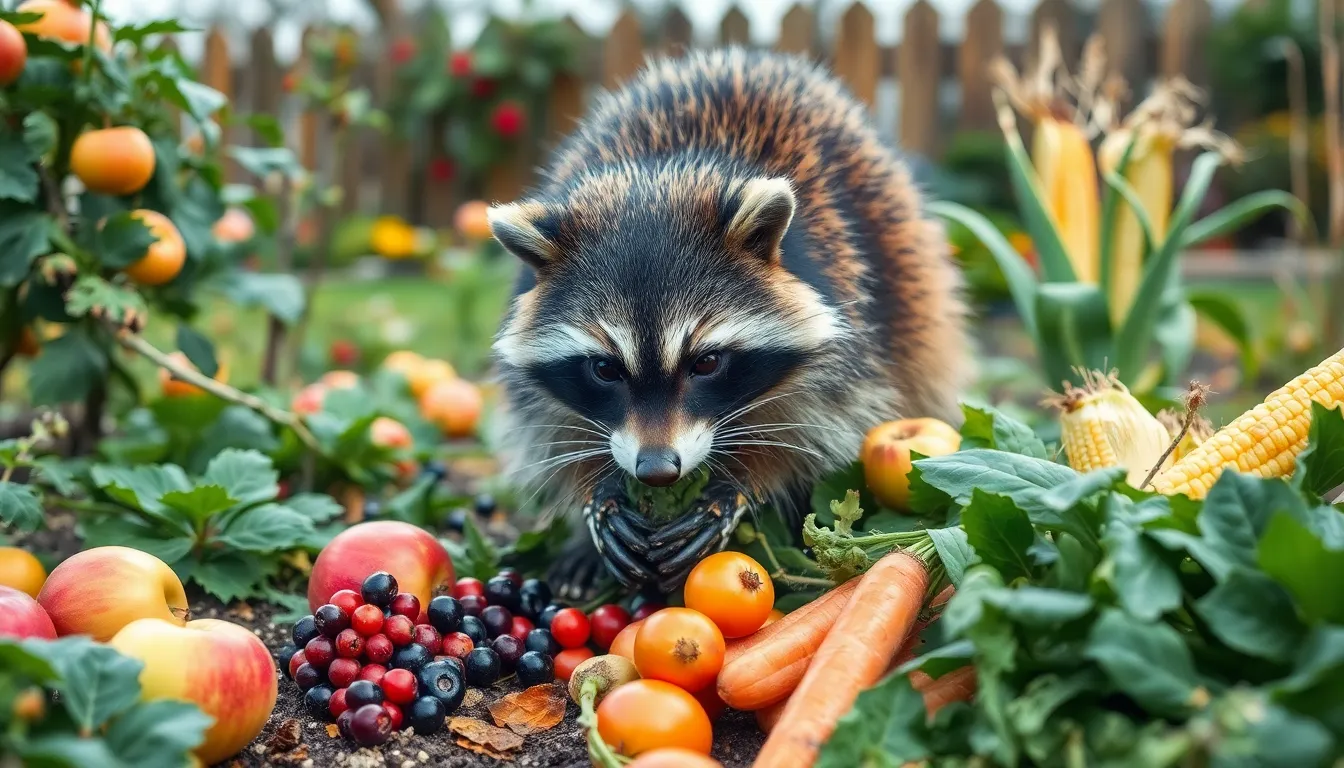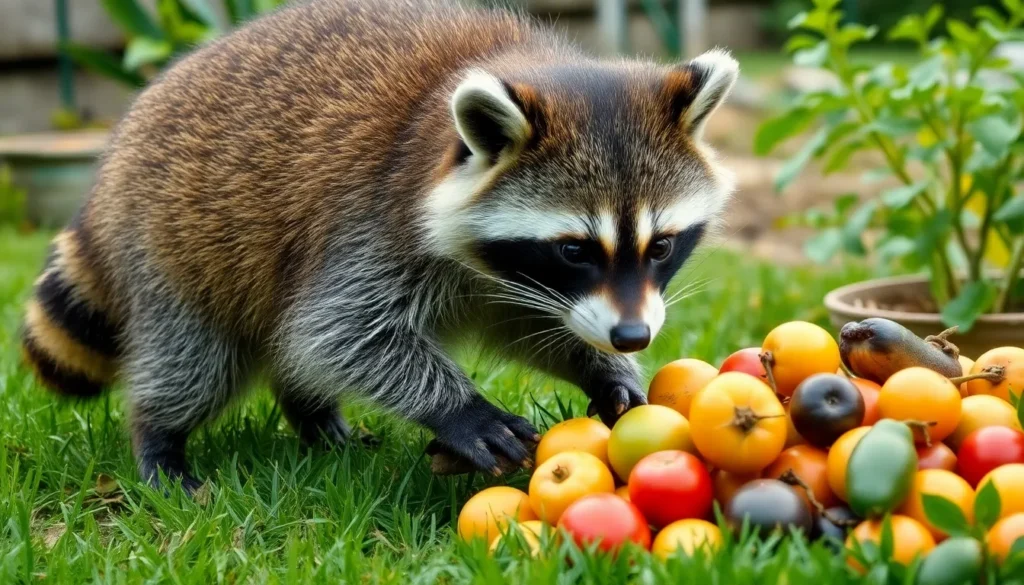Raccoons are nature’s little bandits, known for their masked faces and clever paws. But what do these adorable mischief-makers actually like to munch on? If you’ve ever spotted one rummaging through your trash, you might’ve wondered if it’s just after last night’s pizza leftovers or something more gourmet.
Table of Contents
ToggleOverview of Raccoon Diet
Raccoons primarily consume omnivorous diets. They enjoy a mix of plant-based foods and animal protein sources. Common items on their menu include fruits, nuts, and vegetables. Increased scavenging behavior leads to various human food scraps in urban settings.
Fruits such as apples, berries, and grapes appeal to them significantly. Nut varieties like acorns and walnuts often attract raccoons during the fall. They also munch on vegetables, including corn and carrots, often found in gardens.
On the animal side, raccoons eat insects, small mammals, and birds. Crustaceans are another favorite, especially when they forage near water bodies. Their strong front paws allow them to manipulate objects and access food sources easily.
Human food also plays a large role in raccoon diets. They habitually raid trash cans for leftovers like pizza, pasta, and other discarded items. Raccoons adapt quickly to available food resources, often choosing calorie-dense options.
Diet preferences may shift based on seasonal availability. In spring, young raccoons tend to hunt for insects and small animals. During winter, they rely more on stored fat reserves and foraging in snow-covered areas.
Over time, this adaptability ensures their survival in various environments. Raccoons exhibit significant versatility in their dining habits, preferring accessible and nutritious food sources. Understanding their dietary needs aids in managing their presence in both rural and urban areas.
Common Foods in Raccoon Diet

Raccoons enjoy a wide variety of foods, reflecting their omnivorous nature. Their diet includes an array of fruits, vegetables, insects, and small animals.
Fruits and Vegetables
Fruits such as apples, berries, and grapes attract raccoons in warm months. These creatures also favor nuts like acorns and walnuts, especially during fall when these foods are abundant. Vegetables also pique their interest; raccoons often forage for items like corn and carrots in gardens. Sweet and nutrient-rich, fruits and vegetables provide essential vitamins and sugars, making them vital food sources. Raccoons actively seek out these alternatives in rural environments, but they’ll raid urban gardens and trash for easy access.
Insects and Small Animals
Insects play a critical role in the raccoon diet, particularly during spring when they emerge. These animals hunt for beetles, crickets, and larvae, offering a protein boost. Small mammals and birds also fall prey to raccoons; they capture creatures like rabbits and nesting birds when necessary. Foraging near water sources often yields crustaceans, such as crayfish, which serve as a tasty snack. Versatile in their hunting tactics, raccoons adapt their search for insects and animals based on availability and season, ensuring a balanced diet.
Nutritional Needs of Raccoons
Raccoons require a balanced diet to thrive, reflecting their omnivorous nature. Their nutritional needs include protein and carbohydrates, both essential for energy and overall health.
Protein Requirements
Protein plays a critical role in raccoons’ diets. This macronutrient supports growth, repair, and maintenance of body tissues. Raccoons often consume small mammals, birds, and insects to fulfill protein needs. For instance, beetles and crickets provide vital protein during spring foraging. Incorporating high-protein foods ensures raccoons maintain optimal muscle development and strength. Other animal sources, such as crayfish and fish, also offer excellent protein content when raccoons search for food near water sources.
Importance of Carbohydrates
Carbohydrates supply essential energy for raccoons’ active lifestyles. Fruits, vegetables, and nuts serve as rich carbohydrate sources. Apples, berries, and acorns provide not only energy but also vital vitamins and minerals. In late summer and fall, raccoons particularly benefit from carbohydrate-rich foods to build fat reserves for winter. Carbohydrates also aid in sustaining their foraging activities, helping them remain energetic and agile. A varied carbohydrate intake supports raccoons’ dietary flexibility, allowing them to adapt to seasonal food availability.
Human Foods and Raccoons
Raccoons often consume human food, which significantly influences their diet.
Safe Foods for Raccoons
Fruits like apples, bananas, and berries make excellent options for raccoons. Vegetables, including carrots and leafy greens, provide additional nutrition. Cooked rice and pasta are also safe, offering carbohydrates for energy. Small bits of dog or cat food can supply necessary protein. Treating raccoons to these items can support their health while ensuring a variety in their diet.
Foods to Avoid
Certain human foods pose risks to raccoons. Chocolate contains theobromine, which is toxic to them. Onions and garlic can damage their red blood cells, leading to anemia. Salty snacks, like chips, may cause dehydration and kidney issues. Additionally, dairy products often result in digestive problems. Prioritizing safe options helps maintain their well-being and prevents dietary complications.
Raccoons are resourceful foragers with a varied diet that reflects their adaptability. They thrive on a mix of fruits, vegetables, insects, and small animals, showcasing their omnivorous nature. Their ability to shift dietary preferences based on seasonal availability allows them to maintain their health and energy levels throughout the year.
While human food can be an enticing option for raccoons, it’s crucial to prioritize safe and nutritious choices. Understanding what raccoons like to eat not only enriches knowledge about these fascinating creatures but also aids in managing their interactions with human environments. By respecting their dietary needs, communities can coexist with raccoons while ensuring their well-being.





